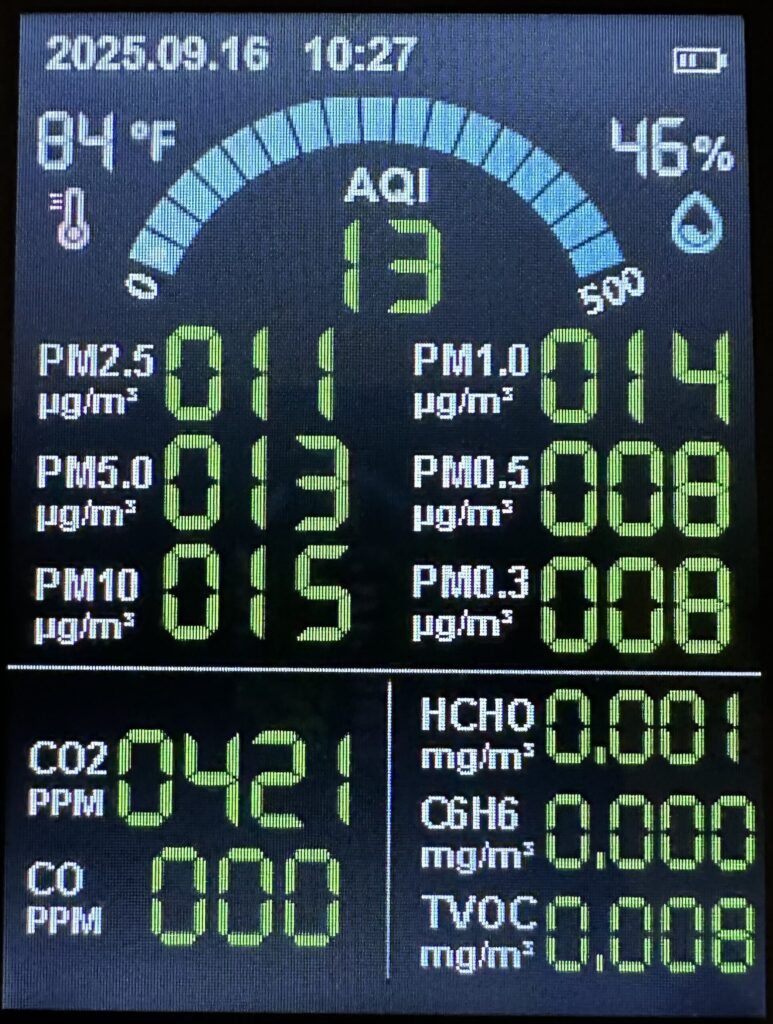What is “good” indoor air quality? How do you measure it? There are air quality monitors that you can use to measure the particulates in the air (dust and other particles) along with various chemicals. You can buy these online for anywhere between $100 and $300 to give you a continuous reading of the air quality.
I don’t think you need to monitor your air quality every day unless you have suspicion that you are in a bad area for air or are having some symptoms that might be caused by poor indoor air quality but you should have it checked at least 3-4 times per year. If you have new furniture, carpet, flooring, paint, or anything else that is large and put in your home, it might be worth checking out the air quality.

Air Quality Parameters
Here are some parameters that might be helpful when determining indoor air quality:
- AQI: Air Quality Index [0-100]– This is an easy number to use to judge overall air quality. It takes into account various parameters to give you a general idea. You might see AQI on your phone or computer. Here’s the new 2024 chart for AQI readings. PM2.5 should be <9.0 for good quality (see next bullet for PM).
- PM10/5/2.5/1.0/0.5/0.3 [2.5: < 9 ug/m3] – Particulate Matter (PM) – This is the size of the matter and reading. The larger the number, the larger the particle size. This is helpful to see if your air filter is working properly at home.
- CO2 – Carbon Dioxide [< 1000 ppm] – This is the carbon dioxide in the air and can give you an idea of the amount of fresh air being allowed in the room or too much consumption of air for your heater. Here’s info on CO2 levels.
- CO – Carbon Monoxide [< 9 ppm] – If it gets high enough, your CO alarm should go off alerting you to a hazardous and potentially deadly environment. You can’t smell CO so having a CO alarm low to the ground (its heavier than air) near areas that have combustion gases (cars/garages, heaters, water heaters, boilers, etc.) will help to alert you of high CO levels. Learn about carbon monoxide here.
- HCHO – Formaldehyde [<0.1 mg/m3] – This is a volatile chemical in many new items including furniture, insulation, floors, etc. This should be kept at <.1 mg/m3 (or .1 ppm) for short-term exposure. If it is higher, increase ventilation until it goes down. Learn about Formaldehyde here.
- C6H6 – Benzene [< 3 mg/m3] – A toxic carcinogen commonly found in some vinyl floors (or Luxury Vinyl Planks – LVP) as well as other products. According to the Occupational Safety and Health Administration (OSHA), this should be kept at <3 mg/m3 over an 8-hour period. Information about Benzene is here.
- TVOC – Total Volatile Organic Compounds (VOC) [0.3-0.5 mg/m3 ]– VOCs are in many products from paints to household chemicals, furniture, and even makeup. Exposure can cause irritation, headaches, dizziness, and respiratory issues. Learn more about VOCs here.
Indoor air quality should be checked on a regular basis to ensure that your filters are working properly and you and your family aren’t being exposed to harmful chemicals.
Indoor air quality checks are performed quarterly (or more often if you need) in all of our Home Hero HomeCare maintenance plans. Learn more about our plans here.

Leave a Reply